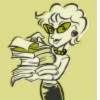 Choldenko, Gennifer. 2004. AL CAPONE DOES MY SHIRTS. New York: G.P. Putnam’s Sons. ISBN 0-399-23861-1
Choldenko, Gennifer. 2004. AL CAPONE DOES MY SHIRTS. New York: G.P. Putnam’s Sons. ISBN 0-399-23861-1AL CAPONE DOES MY SHIRTS is a collection of journal entries by Matthew “Moose” Flanagan. Moose’s life is not unlike that of a typical seventh grader—except that his older sister is autistic, his father is an electrician/prison guard, and he lives on Alcatraz Island. The characters’ traits unfold through a combination of dialog, action, and narrative. The family moved to Alcatraz to take advantage of an educational opportunity for his sister. Though he deeply resents the move, Moose, a self-proclaimed good boy, always does what he’s supposed to do and “tries very hard not to get angry with his sister.” Moose’s desire to have a “normal” family and do the right thing permeates everything he does. The island and its buildings and characteristics are explicitly described. The year is both included in the journal entries as well as alluded to in the title and text. Contemporary references to Al Capone, joblessness, and inkwells support the story’s 1930s era. The dialog and narrative are natural and flow easily—not at all encumbered by an author’s need to clarify the time period or force feed historical tidbits. The historical era and setting add to this story’s uniqueness and appeal. Even if the reader does not have a developmentally disabled family member, the target audience will empathize with the protagonist’s struggle to fit in socially and be a positive force within his family.
Selected as a Newbery Honor Book in 2005, this historical fiction novel is highly recommended for readers grades 5-9.



